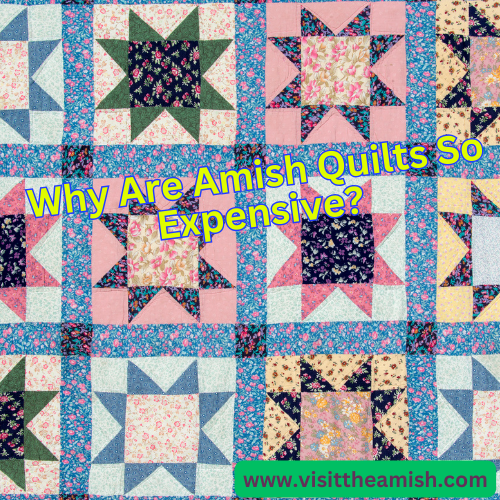Unraveling the Mystique: The Economics and Culture Behind the High Cost of Amish Quilts
In the world of textiles and handicrafts, few items command as much attention and admiration as Amish quilts. Renowned for their exquisite craftsmanship, intricate designs, and timeless appeal, these quilts often carry a hefty price tag that leaves many wondering: why are Amish quilts so expensive? Delving into the economics, culture, and craftsmanship behind these iconic pieces reveals a complex tapestry of factors that contribute to their high cost.
Cultural Heritage and Artistry: A Tradition Passed Down Through Generations
At the heart of the Amish quilt tradition lies a deep reverence for heritage and craftsmanship. For centuries, quilting has been an integral part of Amish culture, with women passing down their skills and techniques from one generation to the next. Each quilt is a labor of love, painstakingly pieced together using time-honored methods and often featuring intricate patterns and motifs that reflect the values and beliefs of the Amish community.

The level of skill and artistry required to create an Amish quilt is unparalleled, with quilters often spending hundreds of hours meticulously stitching each piece by hand. From selecting the finest fabrics to carefully coordinating colors and patterns, every aspect of the quilting process is infused with care and attention to detail. This dedication to quality and craftsmanship is a hallmark of Amish quilts and contributes to their enduring allure.
Limited Production and Rarity: Supply and Demand Dynamics

One of the key factors driving the high cost of Amish quilts is their limited production and relative rarity. Unlike mass-produced quilts churned out by factories, Amish quilts are typically handmade in small batches by skilled artisans within Amish communities. This limited supply, combined with high demand from collectors and enthusiasts, creates a market dynamic where prices are naturally elevated.
Furthermore, the time-intensive nature of quilt-making means that only a finite number of quilts can be produced within a given timeframe. As a result, each Amish quilt becomes a coveted treasure, with collectors willing to pay a premium to acquire these one-of-a-kind pieces. This scarcity value further contributes to the perceived value and high cost of Amish quilts in the marketplace.
Quality of Materials and Craftsmanship: A Commitment to Excellence
Another factor that contributes to the expense of Amish quilts is the quality of materials and craftsmanship involved in their creation. Amish quilters are known for their discerning eye for detail and insistence on using only the finest fabrics and supplies available. From high-quality cottons and wools to meticulously sourced batting and thread, every component of an Amish quilt is carefully selected to ensure durability, longevity, and visual appeal.
Additionally, the hand-stitching techniques employed by Amish quilters result in seams that are not only strong and durable but also lend a distinctive aesthetic charm to the finished quilt. These meticulous stitching methods, coupled with the use of premium materials, contribute to the overall value and perceived quality of Amish quilts, justifying their higher price point compared to mass-produced alternatives.
Cultural and Artistic Significance: A Reflection of Values and Traditions

Beyond their material and aesthetic qualities, Amish quilts hold a deeper significance as cultural artifacts and expressions of identity. Rooted in the values of simplicity, tradition, and community, these quilts serve as tangible manifestations of Amish heritage and beliefs. From the selection of traditional patterns and motifs to the communal aspect of quilt-making itself, every aspect of the quilting process is imbued with cultural meaning and significance.
For many Amish quilters, the act of creating a quilt is not merely a practical endeavor but a spiritual one, with each stitch serving as a form of meditation and reflection. This deep connection to tradition and spirituality infuses Amish quilts with a sense of authenticity and authenticity that resonates with collectors and enthusiasts around the world, further elevating their cultural and artistic significance.
Conclusion: A Tapestry of Value and Tradition
In conclusion, the high cost of Amish quilts can be attributed to a combination of factors, including their cultural heritage, limited production, quality craftsmanship, and artistic significance. From their intricate designs and meticulous stitching to their cultural and spiritual significance, these quilts represent far more than mere textiles – they are tangible expressions of tradition, craftsmanship, and community.
While the price of an Amish quilt may seem steep to some, it is a reflection of the time, skill, and cultural value invested in its creation. For collectors and enthusiasts, the opportunity to own a piece of Amish history is worth every penny, as these quilts serve as enduring reminders of a rich and vibrant heritage that continues to inspire and captivate to this day.
Amish Quilt Shops
- Amish Country Quilts
- Address: 4300 Township Road 356, Berlin, OH 44610
- Website: www.amishcountryquilts.com
- Miller’s Dry Goods
- Address: 4500 State Route 557, Millersburg, OH 44654
- Website: www.millersdrygoods.com
- Helping Hands Quilt Shop
- Address: 4818 US-62, Millersburg, OH 44654
- Website: www.helpinghandsquilts.com
- Keim Family Market & Quilt Shoppe
- Address: 2621 Burnt Cabin Road, Seaman, OH 45679
- Website: www.keimfamilymarket.com/quilt-shoppe
- Lehman’s Quilt Shop
- Address: 4779 Kidron Road, Dalton, OH 44618
- Website: www.lehmans.com/quilt-shop
- Zinck’s Fabric Outlet
- Address: 4568 State Route 39, Berlin, OH 44610
- Website: www.zincksfabric.com
- Lancaster County Quilts
- Address: 123 Main Street, Lancaster, PA 17603
- Website: www.lancastercountyquilts.com
- Dutch Country Quilts
- Address: 456 Elm Street, Intercourse, PA 17534
- Website: www.dutchcountryquilts.com
- Amish Quilt Shoppe
- Address: 789 Mill Road, Bird-in-Hand, PA 17505
- Website: www.amishquiltshoppe.com
- Amish Quilts of Shipshewana
- Address: 321 E Main St, Shipshewana, IN 46565
- Website: www.amishquiltsofshipshewana.com
- Yoder’s Amish Quilts
- Address: 123 Market Street, Shipshewana, IN 46565
- Website: www.yodersamishquilts.com
- Nana’s Amish Quilts
- Address: 456 Country Road, Middlebury, IN 46540
- Website: www.nanasamishquilts.com

